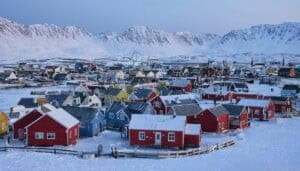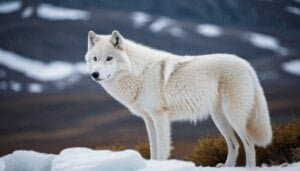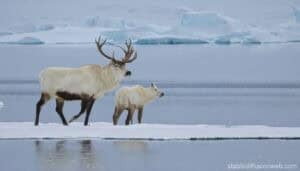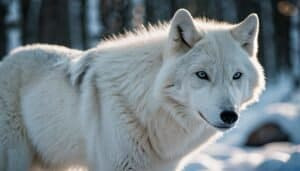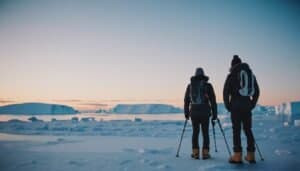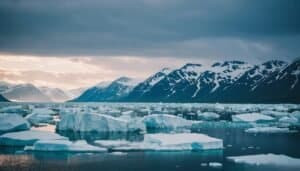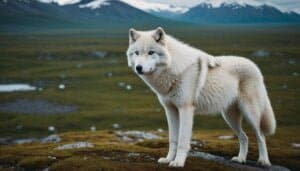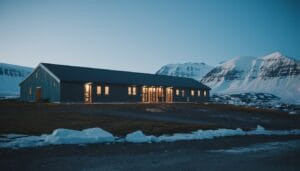Introduction
Arctic wolves, iconic inhabitants of the frozen north, face significant challenges as global warming reshapes their environment
This article delves into the multifaceted impact of climate change on Arctic wolves, exploring habitat alterations, population dynamics, and the broader ecological implications. We will examine scientific research methods, key findings, and the difficulties in studying these elusive predators
Furthermore, we’ll discuss conservation efforts, highlighting the roles of policies, organizations, and communities in safeguarding Arctic wolves for future generations
Impact of Global Warming on Arctic Wolves
As global warming accelerates, the Arctic region undergoes dramatic environmental changes, profoundly affecting the Arctic wolf (Canis lupus arctos). Understanding these impacts requires examining the shifts in habitat, population dynamics, and the specific threats posed by climate change
Changes in Arctic Wolf Habitat
Arctic wolves thrive in one of the harshest environments on Earth, where their thick fur and specialized hunting strategies have allowed them to survive in the extreme cold and barren landscapes of the Arctic tundra. However, rising global temperatures are causing substantial shifts in their habitat
The melting of sea ice is one of the most visible signs of global warming, reducing the wolves’ hunting grounds and altering the availability of their primary prey, such as seals and Arctic hares
According to the National Snow and Ice Data Center, the Arctic sea ice extent has declined by approximately 13% per decade since 1979 . This reduction not only limits the area where wolves can hunt but also forces them to travel greater distances, expending more energy and increasing the risk of starvation
Additionally, the permafrost, a critical component of the Arctic landscape, is thawing. The thawing permafrost leads to changes in the terrain, affecting denning sites and the stability of the land. This instability can lead to the collapse of dens, endangering wolf pups
A study published in the journal Nature Communications in 2018 highlighted that permafrost thawing is accelerating and could become irreversible if current warming trends continue
Effects on Arctic Wolf Populations
The direct and indirect consequences of habitat changes significantly impact Arctic wolf populations
With the loss of sea ice and altered prey availability, wolves face increasing difficulties in sustaining their populations. The scarcity of food forces wolves to move into unfamiliar territories, potentially leading to conflicts with other predator species and human settlements
The harsh winters, which once acted as a buffer against diseases, are becoming milder, allowing pathogens and parasites to thrive. Diseases such as rabies and canine distemper, previously rare in the Arctic, are now more common, posing additional threats to wolf populations
Research from the Wildlife Conservation Society indicates that outbreaks of these diseases have increased, correlating with the rising temperatures and more extended periods of ice-free conditions
Moreover, reproductive rates are affected. Female wolves may struggle to find sufficient food to support pregnancy and nursing, leading to smaller litter sizes and higher pup mortality rates. The combined stressors of food scarcity, disease, and habitat loss create a precarious situation for Arctic wolves, with population numbers showing signs of decline in several regions
Primary Climate Change Threats
The primary threats posed by climate change to Arctic wolves are multifaceted
Firstly, the loss of habitat and prey due to melting ice and thawing permafrost directly threatens their survival. Secondly, the increased prevalence of diseases exacerbates the challenges faced by these predators. Lastly, human activities, such as increased shipping, oil exploration, and tourism, introduce additional pressures
Increased human presence in the Arctic disrupts the natural behaviors of wolves and other wildlife. Noise pollution from ships and drilling operations can disturb hunting and breeding activities. Furthermore, oil spills and other environmental contaminants pose severe risks to the delicate Arctic ecosystem
A 2016 report by the Arctic Council highlighted that the Arctic is particularly vulnerable to oil spills, with long-lasting effects on both marine and terrestrial wildlife
Overall, the Arctic wolf’s struggle against the backdrop of global warming is emblematic of the broader environmental crisis facing the Arctic region. These wolves are not only indicators of ecological health but also symbols of the urgent need for climate action to preserve one of the planet’s most fragile ecosystems
Role of Arctic Wolves in the Ecosystem
Arctic wolves play a crucial role in maintaining the balance of the Arctic ecosystem. Their presence influences various aspects of the environment, from the food chain to vegetation patterns. Understanding their role helps in comprehending the broader impacts of their potential decline due to global warming
Importance of Arctic Wolves in the Food Chain
Arctic wolves are apex predators, meaning they sit at the top of the food chain. Their primary diet includes caribou, muskoxen, Arctic hares, and smaller mammals. By preying on these animals, wolves help regulate the populations of their prey, ensuring that no single species dominates the ecosystem
This regulation is vital for maintaining biodiversity. For instance, by controlling the caribou population, wolves indirectly influence the growth and health of vegetation. Overgrazing by caribou can lead to the depletion of certain plant species, affecting the entire plant community and other herbivores dependent on it
A study published in Oecologia in 2017 showed that in areas where wolf populations declined, caribou numbers surged, leading to significant overgrazing and subsequent vegetation loss
Influence on Prey Populations
The predatory activities of Arctic wolves have a profound impact on the behavior and distribution of prey species
Prey animals often alter their grazing patterns and movement routes to avoid wolf territories, which helps distribute grazing pressure more evenly across the landscape. This behavior, known as the “landscape of fear,” creates a dynamic balance within the ecosystem
Moreover, wolves tend to target the weak, sick, or old individuals within prey populations, which can improve the overall health and genetic fitness of these populations. By removing these vulnerable individuals, wolves help prevent the spread of diseases and ensure that the fittest animals survive and reproduce
Research by the University of Alberta in 2019 highlighted that wolf predation plays a crucial role in maintaining the genetic diversity and resilience of prey species
Impact on Vegetation and Landscape
The presence of Arctic wolves indirectly benefits plant communities. By keeping herbivore populations in check, wolves prevent overgrazing, which can lead to soil erosion and degradation. Healthy vegetation cover is essential for soil stability and nutrient cycling, supporting a wide range of plant and animal life
Additionally, wolves’ hunting activities contribute to nutrient redistribution. The remains of their kills provide a source of nutrients for scavengers and decomposers, enriching the soil and promoting plant growth. This nutrient cycling is vital in the nutrient-poor Arctic environment, where organic matter is limited
Furthermore, the influence of wolves extends to aquatic ecosystems. By regulating the populations of herbivores like caribou that graze near water bodies, wolves help protect riparian vegetation
Healthy riparian zones are crucial for maintaining water quality and providing habitat for various aquatic and terrestrial species. A study in Ecology in 2015 found that the presence of wolves was associated with improved riparian vegetation and enhanced biodiversity in nearby water ecosystems
Studying the Effects of Global Warming on Arctic Wolves
Researching the impact of global warming on Arctic wolves is crucial for understanding how these predators and their ecosystems are changing. This section delves into the methodologies used by scientists, key findings from recent studies, and the challenges faced in Arctic wolf research
Research Methods and Technologies
Studying Arctic wolves involves a combination of traditional fieldwork and modern technological approaches. Scientists use GPS collars to track the movement and behavior of wolves across vast and remote Arctic landscapes. These collars provide invaluable data on wolves’ hunting patterns, territory ranges, and interactions with prey and other predators
Camera traps are another essential tool. Strategically placed cameras capture images and videos of wolves in their natural habitat, offering insights into their daily activities and social structures. This non-invasive method minimizes human disturbance, allowing for more natural observations
Drones have also become increasingly important in Arctic research. They offer a bird’s-eye view of wolf habitats, enabling scientists to monitor changes in the environment, such as melting ice and vegetation shifts, more efficiently
Drones can cover large areas quickly, providing high-resolution images and real-time data
Furthermore, researchers employ genetic analysis to study the health and diversity of wolf populations. DNA samples collected from scat, hair, or blood help determine genetic variability, population structure, and relatedness among individuals. This information is crucial for understanding the resilience of wolf populations to environmental changes
Key Findings and Observations
Recent studies have revealed several critical findings about the effects of global warming on Arctic wolves
One significant observation is the northward shift in wolf territories. As southern parts of their range become less habitable due to rising temperatures and melting ice, wolves are moving further north in search of suitable habitats and prey
A 2021 study published in Global Change Biology found that Arctic wolves are experiencing changes in their prey dynamics. The decline in sea ice has reduced the availability of seals, forcing wolves to rely more on terrestrial prey like caribou and muskoxen
This shift not only affects the wolves’ diet but also has broader ecological implications, as it changes the predator-prey relationships within the ecosystem
Another key finding is the increased incidence of disease. Warmer temperatures have facilitated the spread of pathogens and parasites previously uncommon in the Arctic. For example, the emergence of canine distemper and sarcoptic mange among wolf populations has been documented, correlating with milder winters and longer periods of ice-free conditions
Research has also highlighted the impact of human activities on Arctic wolves. The expansion of industrial activities, such as oil and gas exploration, has led to habitat fragmentation and increased human-wolf encounters
Noise pollution from these activities disrupts the wolves’ hunting and communication, while the presence of infrastructure limits their movement and access to prey
Challenges in Arctic Wolf Research
Conducting research in the Arctic presents numerous challenges. The extreme weather conditions and remote locations make fieldwork difficult and expensive
Researchers often have to contend with sub-zero temperatures, blizzards, and limited daylight during the winter months. These conditions can delay or hinder data collection and equipment maintenance
Accessing remote wolf habitats requires significant logistical planning and resources. Transporting equipment, supplies, and personnel to these areas involves high costs and coordination. Additionally, the fragile Arctic environment necessitates careful planning to minimize the ecological footprint of research activities
Another challenge is the limited time window for conducting fieldwork. The brief Arctic summer provides a narrow period for researchers to collect data before winter sets in again. This constraint requires efficient planning and execution of research activities to maximize the data gathered within the short field season
The unpredictable nature of wildlife adds another layer of complexity. Wolves are elusive and cover vast territories, making them difficult to locate and observe consistently. Researchers must often rely on indirect signs, such as tracks and scat, to infer wolf presence and behavior
Conservation Efforts for Arctic Wolves
Protecting Arctic wolves requires a multifaceted approach, combining policy measures, the work of wildlife organizations, and community involvement
These efforts aim to mitigate the impacts of global warming and human activities on Arctic wolf populations, ensuring their survival and the health of the Arctic ecosystem
Protection Policies and Programs
Several policies and programs have been implemented to protect Arctic wolves and their habitat
International agreements, such as the Arctic Council’s Conservation of Arctic Flora and Fauna (CAFF) working group, play a significant role in coordinating conservation efforts across Arctic nations. CAFF promotes the sustainable management of Arctic biodiversity and develops strategies to combat the effects of climate change
National governments also implement specific measures to protect Arctic wolves. For example, Canada’s Species at Risk Act (SARA) provides legal protection to threatened species, including Arctic wolves, and mandates the development of recovery strategies and action plans. Similarly, Greenland has enacted laws to regulate hunting and ensure sustainable wildlife management
Protected areas are crucial for the conservation of Arctic wolves. Establishing national parks and wildlife reserves helps preserve critical habitats and provides safe havens where wolves can thrive without the threat of human interference
The establishment of protected areas, such as the Arctic National Wildlife Refuge in Alaska and Quttinirpaaq National Park in Canada, has been instrumental in safeguarding key habitats for Arctic wolves
Role of Wildlife Organizations
Wildlife organizations play a vital role in Arctic wolf conservation. These organizations conduct research, raise awareness, and advocate for policies that protect wolves and their habitats
The World Wildlife Fund (WWF), for instance, focuses on preserving Arctic ecosystems through initiatives that address climate change, protect species, and promote sustainable development
The Wildlife Conservation Society (WCS) is another key player in Arctic wolf conservation. WCS conducts scientific research to monitor wolf populations, assess threats, and develop conservation strategies. Their work includes satellite tracking of wolves to understand their movements and interactions with other species and habitats
Moreover, organizations like Polar Bears International and the Arctic Wolf Project engage in public outreach and education
They provide resources and programs to inform the public about the importance of Arctic wolves and the challenges they face. By increasing awareness, these organizations foster public support for conservation efforts and encourage responsible behavior in Arctic regions
Community Involvement and Education
Community involvement is essential for the success of conservation efforts. Indigenous communities, who have lived in the Arctic for millennia, possess invaluable knowledge about the local environment and wildlife. Collaborating with these communities ensures that conservation strategies are culturally sensitive and incorporate traditional ecological knowledge
Community-based monitoring programs empower local residents to participate in wildlife research and conservation
These programs train community members to collect data on wolf sightings, track movements, and monitor environmental changes. This collaborative approach not only enhances data collection but also strengthens the relationship between scientists and local communities
Education initiatives are critical for fostering a conservation ethic among the broader public. Schools, museums, and environmental organizations offer programs that teach about Arctic wolves, climate change, and the importance of biodiversity. These educational efforts aim to inspire the next generation of conservationists and encourage sustainable practices
For instance, the Arctic Wolf Education Program provides resources and curricula for educators to teach students about Arctic wolves and their environment. By incorporating interactive and experiential learning, these programs engage students and promote a deeper understanding of conservation issues
Conclusion
The Arctic wolf, a symbol of the resilience and beauty of the Arctic region, faces unprecedented challenges due to global warming
This article has explored the multifaceted impacts of climate change on these apex predators, including habitat loss, shifting prey dynamics, and increased disease prevalence. As global temperatures rise, the wolves are forced to adapt to rapidly changing environments, threatening their survival and the balance of the Arctic ecosystem
Arctic wolves play a critical role in maintaining the health of the Arctic environment. Their influence on prey populations and vegetation patterns underscores their importance in biodiversity conservation. The decline of Arctic wolves could have cascading effects, disrupting the delicate equilibrium of the ecosystem
Research efforts, utilizing advanced technologies and methodologies, provide essential insights into the wolves’ adaptation to climate change
However, these studies face significant challenges due to the harsh Arctic conditions and the elusive nature of wolves. Despite these obstacles, continued research is vital for developing effective conservation strategies
Conservation efforts for Arctic wolves are multifaceted, involving protective policies, the dedicated work of wildlife organizations, and active community participation. International agreements, national regulations, and the establishment of protected areas are crucial for safeguarding wolf habitats
Wildlife organizations contribute through research, advocacy, and public education, while community involvement ensures that conservation strategies are inclusive and effective
The survival of Arctic wolves amidst global warming depends on a concerted effort from governments, organizations, scientists, and communities. Protecting these iconic predators is not only crucial for maintaining Arctic biodiversity but also for preserving the broader ecological health of one of the planet’s most fragile regions
The ongoing commitment to understanding and mitigating the impacts of climate change will be key to ensuring a future where Arctic wolves continue to thrive



